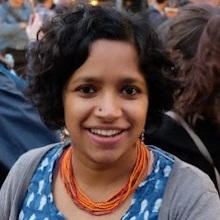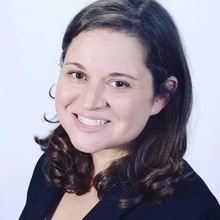What We're Reading For International Women's Day
Sunday, March 8 is International Women’s Day. To mark the occasion, staff members from IPA’s Financial Inclusion and Small & Medium Enterprise programs are highlighting some readings they find insightful, especially as they pertain to new thinking about women’s entrepreneurship and access to finance in low- and middle-income countries.
Elizabeth Koshy, Program Manager, Small & Medium Enterprises

I really like the Household Matters paper by Arielle Bernhardt, Erica Field, Rohini Pande, and Natalia Rigol. Previous studies from Ghana and Sri Lanka had shown that on average, grants helped male microentrepreneurs grow their business, but not female ones. Did this suggest that there was less to be gained from supporting female entrepreneurs? In this paper, the researchers took the data from these Ghana and Sri Lanka studies, also bringing in their own study in India, and re-analyzed it by breaking female-owned micro-enterprises into two categories: ones that were the sole household business, and ones that were one of two or more household businesses. They discovered that female micro-entrepreneurs typically live in households that own multiple businesses—and that they typically operate the least profitable business in the household.
As a result, when female entrepreneurs in households where their husbands also own a business were given grants, they tended to invest them in their husband’s business, as they perceived them to be the higher-return. On the other hand, women with the sole household business saw solid and positive returns to capital in their own businesses.
This paper highlights an important lesson: that women entrepreneurs do make sound financial decisions, but research and programming that aims to help women grow their own businesses must recognize and account for how financial decisions get made within households. A grant to a woman entrepreneur alone might not end up financing that woman’s business. As the SME program puts together a research agenda on promoting women’s entrepreneurship in the next few months, understanding how female entrepreneurs make investment decisions about their business and what enables their growth are questions we’re going to be busy thinking about, and this paper is helping us think through a key piece of the puzzle.
Lucia Sanchez, Program Director, Small & Medium Enterprises

A recent study that I find particularly interesting for its implications for women entrepreneurs is the one on personal initiative training to small businesses in Togo. Governments, nonprofits, and multilateral organizations have spent huge amounts of money teaching entrepreneurs how to use better business practices, from financial management and accounting to marketing and sales. However, the evidence on these traditional training programs is mixed, and most studies show limited to no impact on business outcomes, especially for women entrepreneurs.
In this study, researchers Francisco Campos, Michael Frese, Markus Goldstein, Leonardo Iacovone, Hillary C. Johnson, David McKenzie, and Mona Mensmann examined the effects of an innovative, psychology-based training program that focuses on personal initiative skills. Instead of teaching business skills like accounting, this training focused on skills like developing a self-starting, future-oriented, and proactive mindset, identifying and exploiting new opportunities, goal-setting, planning and feedback cycles, and overcoming obstacles. For example, participants had to think creatively about a new product they could sell by combining other kinds of things that were already available. The research team ran an RCT with 1,500 entrepreneurs in Togo to test it against traditional business training, and found that personal initiative training increased firm profits by 30 percent, while the traditional business training had no significant impact. Business owners who attended the personal initiative training also had a boost in innovation, borrowed more, and made larger investments. The effects for women entrepreneurs were especially large: their profits increased by 40%, compared to no significant impact for traditional business training.
This is a very important result, because it means that personal initiative training could be a powerful tool to help women-led businesses grow and bridge the gender gap in entrepreneurship (i.e. women around the world run fewer businesses than men, their businesses are typically smaller, have fewer employees, are less productive, and are more likely to be informal and subsistence-level). More research will be needed to understand why this particular training is working so well for women, but researchers think it might be related to the fact that it challenges traditional gendered social roles and invites women to be proactive, take risks, develop resilience, and grow a passion for their own business. In order to advance this research agenda, the SME Program recently awarded the Path to Scale Award to the authors of this study, and we are now supporting a replication study, currently underway in Ecuador.
As we start seeing more research on entrepreneurship that incorporates a gender lens, we’ll be able to better understand what’s driving the observed differences between male- and female-led businesses, and what policies are the most effective to address the constraints that women entrepreneurs face. The SME Program has made this agenda a strategic priority for the coming years.
Kate Glynn-Broderick, Associate Director, Financial Inclusion

The global economy is missing out on $160 trillion in wealth, based on the earnings difference between men and women, according to this World Bank report which looked at 141 countries. While the sources of these gaps are no doubt many, I liked this blog post by Harvard Business summarizing several experimental studies of professor Catherine Coffman on how women and men perceive their own competencies, based on tests given just for the purposes of the study. The first paper found that both genders exaggerated the actual gap between men and women in gender-stereotypical content areas (tests on culture and verbal vs. math and sports topics). A second study looks specifically at how participants guessed their own skill level on general knowledge tests found that women consistently underestimated their own performance, and found And in predicting their own abilities, women had much less confidence in their scores on the tests they believed men had an advantage in. The third looked at actual discussion groups and gender composition. “Gender stereotypes determine people’s beliefs about themselves and others,” Coffman says. “Women are more likely than men to shrug off the praise and lowball their own abilities.
Rebecca Rouse, Program Director, Financial Inclusion

I have a lot of pet peeves when it comes to how businesses design and market products for women (see this recent advertisement from Sears in Mexico offering up 47% off washing machines for International Women’s Day to fully connect with my anger). Working in financial inclusion, I’ve seen my fair share of pink debit cards and spa loyalty programs pitched as a way to expand women’s access to financial services:


(I don’t mean to keep calling out Mexico, but… come on!)
I love a good spa day as much as anybody else, but at IPA’s Financial Inclusion Program, we’ve been wondering how we get past lip service and to serious financial products geared towards the challenges women face. A paper that really helped shape my thinking in this is from researchers Clara Delavallade, Felipe Dizon, Jean-Paul Petraud, and Ruth Vargas Hill with IPA in Burkina Faso and Senegal. Poor farmers there are the mercy of the weather and constantly face food insecurity. The researchers compared three types of savings products and weather insurance on farm output and well-being and specifically looked at if women had different preferences. Since weather affects everyone, one assumption may be that gender shouldn’t impact demand for insurance to guard against this risk.
By now you can probably see where I’m going with this—the study found that women invested 30% less than men in the weather insurance product, despite the product’s positive impact, leaving them at a disadvantage. The researchers hypothesized that women may have felt that the weather insurance product didn’t address the true risk to their livelihoods that they face—risks of childbirth or lost income due to health problems or time off to care for a sick child. In the absence of the right insurance product for that need, a savings product may be more attractive. By testing out products in this way, and taking a look at gender disaggregated results, we start to get a clearer picture of what it means to design and market products for women in a meaningful way.











